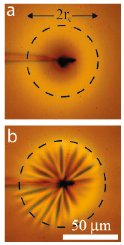Mechanical instability of membranes
C. Tassius and J.-C. Géminard
Collaboration : R. Bernal and F. Melo (USACH, Chile).
 Starting from a polymeric-fluid droplet, by vulcanization of the fluid free surface, curved elastic membranes, several nanometers thick and a few millimeters in diameter, which enclose a constant fluid volume, are produced. In an indentation-type test, carried out by pushing the membrane along its normal by means of a micro-needle, under some conditions, wrinkles are likely to appear around the contact region. Interestingly, we observe that the instability does not significantly alter the force-displacement relation: the relation between the force and the displacement remains linear and the associated stiffness is simply proportional to the tension of the membrane. In addition, we determine that the wrinkles develop when the stretching modulus of the membrane compares with its tension, which provides a useful method to estimate the elastic constant.
Starting from a polymeric-fluid droplet, by vulcanization of the fluid free surface, curved elastic membranes, several nanometers thick and a few millimeters in diameter, which enclose a constant fluid volume, are produced. In an indentation-type test, carried out by pushing the membrane along its normal by means of a micro-needle, under some conditions, wrinkles are likely to appear around the contact region. Interestingly, we observe that the instability does not significantly alter the force-displacement relation: the relation between the force and the displacement remains linear and the associated stiffness is simply proportional to the tension of the membrane. In addition, we determine that the wrinkles develop when the stretching modulus of the membrane compares with its tension, which provides a useful method to estimate the elastic constant.
Elastic response and wrinkling onset of curved elastic membranes subjected to indentation test,
R. Bernal, Ch. Tassius, F. Melo and J.-Ch. Géminard, Eur. Phys. J. E 34, (2011) 13.
Mechanical characterization of elastic membranes: Cell mechanics applications,
Bernal R., C. Tassius, Géminard J.-C. and Melo F., Appl. Phys. Lett. 90 (2007) 063903.




